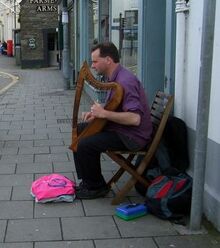
Wikipedia Commons. Harpist in Fishguard Square Busking with a small lap harp to raise money for charity.
Given that one’s lap is positioned roughly at the bottom end of one’s torso, and one’s torso is a fixed size regardless of seating position, it is obvious that such a range in sizes are definitely not “one lap fits all”. In addition, many harp players have more than one harp and chances are good that the two harps vary in height. All of which leads to the question of how to best position a lap harp for comfortable playing?
The name “lap harp” is something of a misnomer. Yes, it is a harp. But whether it really sits in one’s lap is a matter of human physiology and harp size. Lap harps are designed to be played “off the floor”. The height of the sound-box (which rests on the shoulder) can range in size from as little as 24″ to as high as 38″ or more. Given that one’s lap is positioned roughly at the bottom end of one’s torso, and one’s torso is a fixed size regardless of seating position, it is obvious that such a range in sizes are definitely not “one lap fits all”.
In addition, many harp players have more than one harp and chances are good that the two harps vary in height. All of which leads to the question of how to best position a lap harp for comfortable playing?
Here are some methods used by other lap harp players:
- Knee Bar or Knee “Bone”: This is a piece of wood that is attached laterally to the bottom of the harp to form a bar or brace for propping on the lap. Some harps come with an attachable bar, but some harp players have elected to create their own.
- Stool or Bucket: Use a small stool or even a bucket (paint buckets with lids from hardware stores seem to work well, and can double as a carryall for music). The stool or bucket is positioned between the knees and the harp is placed upon it. Stools of varying heights may be needed depending on the chair used for playing. Tower Stools makes a great folding stool (easy to pack in your case for travelling) that comes in a variety of sizes.
- Calf Placement: This strategy doesn’t relay on any outside tools or implements. Simply cross the ankles and place the harp in the space between the ankles and knees, resting against the calves of the legs.
- Shelf Liner or Mat: Rubberized kitchen shelf liner can be purchased at many department stores or pharmacies and can be used to either keep the harp from sliding when positioned on a stool, bucket, or board, or can be draped over the lap to keep the harp stable. As an alternative, rubber mats commonly placed under computers or other equipment can be purchased at office supply stores. While thicker and less flexible, they will help with slippage.
- Board: Cut or buy a rectangular board that is wide enough to sit on and long enough to extend beyond the lap. Sit on one end of the board with the other end protruding from between the knees. Position the harp on the board (perhaps using the shelf liner as a stabilizer). Boards can be plain or padded for extra comfort.
- Harp Strap: Some lap harps are made to accommodate the addition of a strap so that the harp can be affixed to the shoulder and back. Check with your harp maker to see if this is available for your harp model.
- Harp Sling: Many people have created hand-made “harp bras”. The idea is to “cup” the bottom of the harp with a padded fabric, and attach a fabric sling to either side of the “cup” so that the harp can sit on a board, the lap, or between one’s legs, and be held in place by the sling around the back of the neck.
- Le Stik (by Blevins Harps): Depending on whether or not your lap harp has rear or front sound holes, the Le Stik by Blevins Harps may be just the ticket. This apparatus is a stick that clamps to the back of the bottom sound hole on the harp and props it up. Le Stik may not work on all harps, so check with them first before ordering.
References[]
Note about this article. Some of this content has been copy-pasted from Peggy Coates' website dorveille.com The website has disappeared, but the content remains on the internet archives. Attempts have been made to get in touch with the original author, but have been unfruitful. Should Peggy come across this content, please get in touch with @harpwiki!
